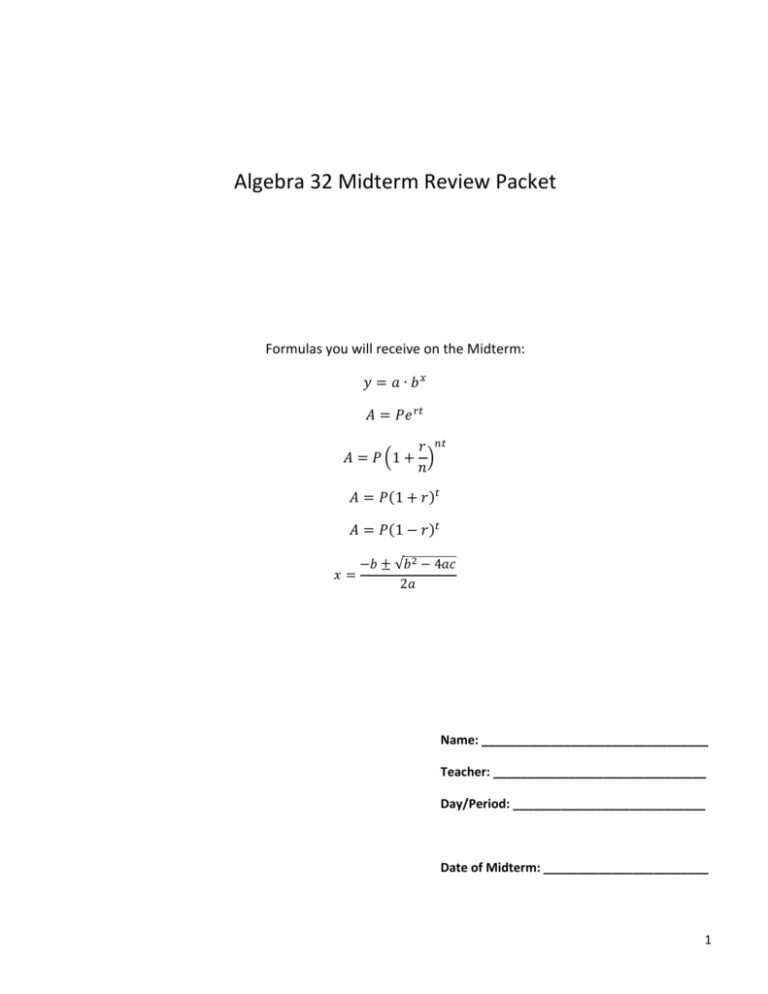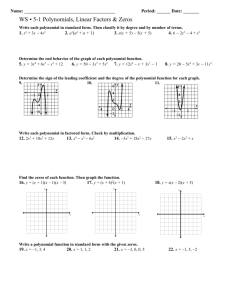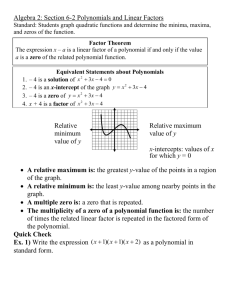Algebra 32 Midterm Review Packet
advertisement

Algebra 32 Midterm Review Packet Formulas you will receive on the Midterm: 𝑦 = 𝑎 ∙ 𝑏𝑥 𝐴 = 𝑃𝑒 𝑟𝑡 𝑟 𝑛𝑡 𝐴 = 𝑃 (1 + ) 𝑛 𝐴 = 𝑃(1 + 𝑟)𝑡 𝐴 = 𝑃(1 − 𝑟)𝑡 𝑥= −𝑏 ± √𝑏 2 − 4𝑎𝑐 2𝑎 Name: _________________________________ Teacher: _______________________________ Day/Period: ____________________________ Date of Midterm: ________________________ 1 Functions: Vocabulary: o Domain (Input) & Range (Output) o Increasing & Decreasing o Minimum & Maximum Types of Functions: o Linear, Quadratic (parabola), Cubic, Quartic, Polynomial o Piecewise o Absolute Value Evaluate functions for values without a calculator by direct or synthetic substitution Transformations on Functions o Translations (left, right, up, down) o Reflections (over x-axis or y-axis) o Dilations (vertical stretch or shrink) Inverses of Functions o For a table: switch the x and y o For equations: switch the x and y and solve for y 1) Answer the following questions about the graph f(x). a) Use interval notation: f(x) Domain: _________________________ Range: ___________________________ On what interval is f(x) decreasing? ______________ b) What is the maximum? ___________________ c) Estimate the x-intercepts: ___________ & ___________ d) Estimate the following using the graph: a. f(1) b. f(0) c. f(x) = -4 2) Use the function 𝑔(𝑥) = 𝑥 4 − 3𝑥 2 to answer the following questions without a calculator: a) Find the value of g(x) when x = 1 b) Find the value of g(x) when x = -1 3) Find the value of f(x) = -2x + 8 when a) x = 8 b) f(x) = 12 c) x = -2 d) f(x) = 16 e) x = -½ 2 4) Use the function ℎ(𝑥) = 𝑥 3 + 2𝑥 2 + 4𝑥 + 2 to answer the following questions without a calculator: a. Find the value of h(x) when x = –1 b. Find the value of h(x) when x = 2 5) Answer the following questions about the piecewise function shown below. a) Use interval notation: Domain: _____________________ Range: ______________________ b) What is the y-intercept? ___________________ c) What is the x-intercept? ___________________ f(x) d) Estimate the following using the graph: a. f(2) b. f(-1) c. f(x) = -2 d. f(x) = 4 6) Describe the transformations in detail: reflect over y axis, translate left 2, dilation- vertical stretch, etc… a) 𝑓(𝑥) + 10 b) 𝑓(𝑥 − 7) − 2 c) 𝑓(−𝑥) d) −𝑓(𝑥) e) 3𝑓(𝑥) f) 1 𝑓(𝑥) + 2 5 g) −𝑓(𝑥 + 4) 7) Describe how the parent functions 𝑔(𝑥) = |𝑥|, ℎ(𝑥) = 𝑥 2 and 𝑘(𝑥) = √𝑥 are transformed. a) b) c) d) 𝑔(𝑥) = |𝑥| − 4 𝑔(𝑥) = |𝑥 + 2| + 6 𝑔(𝑥) = 3|𝑥| + 8 𝑔(𝑥) = −2|𝑥 − 3| 1 2 e) 𝑔(𝑥) = |𝑥 + 4| − 1 f) ℎ(𝑥) = −(𝑥)2 g) ℎ(𝑥) = (𝑥 + 1)2 − 4 h) ℎ(𝑥) = 4(𝑥 − 1)2 i) 𝑘(𝑥) = √(𝑥 + 1) − 2 j) 𝑘(𝑥) = √𝑥 − 2 1 k) 𝑘(𝑥) = 3 √𝑥 3 8) Graph the equations: a) 𝑦 = 2|𝑥 − 1| − 4 b) 𝑦 = −|𝑥 + 2| + 3 9) Which of the options is the equation for the graph shown below? a) 𝑦 = |𝑥 − 4| − 2 b) 𝑦 = |𝑥 − 4| + 2 c) 𝑦 = |𝑥 + 4| + 2 d) 𝑦 = |𝑥 + 4| − 2 10) Determine the inverses of the following functions: a) b) c) d) e) 𝑓(𝑥) = √𝑥 + 2 𝑦 =𝑥+8 3 𝑓(𝑥) = √𝑥 − 1 𝑓(𝑥) = √𝑥 + 7 𝑦 = 2𝑥 − 9 f) 𝑦 =− 𝑥+4 1 2 11) Use the table for f(x) to find the values of its inverse function f -1(x). a) x 2 4 6 8 10 f(x) 1 3 5 7 9 x f -1(x) 4 b) x -8 -9 -15 -18 -22 f(x) 5 6 8 10 13 x 12) Perform the given transformation: a) c) f -1(x) b) d) 5 Polynomials: Vocabulary: o Leading Coefficient and Degree o Real vs. Complex Solutions o Zeros = x-intercepts = roots = solutions o y-intercept o end behavior o Standard and Factored Form o imaginary and complex numbers Skills: o Find values of polynomials by either direct or synthetic substitution o Add/Subtract/Multiply/Divide polynomials Long or Synthetic Division o Factor polynomials: Always start by looking for a GCF Next, look for perfect squares Lastly, use the box method or grouping where appropriate Always re-check your factors to see if they can be factored further o Finding potential rational roots of polynomials and determining actual roots o Graphing Polynomials (without a calculator): Finding relative min and max of a graph From factored form or standard form Understand end behavior and shape from degree and leading coefficient In factored form: roots that touch vs. cross 13) Show all work as you perform the indicated operation: a) b) c) d) e) f) (4𝑥 4 + 3𝑥 3 − 2𝑥 + 9) + (5𝑥 3 − 2𝑥 2 − 3) (8𝑥 3 − 2𝑥 2 + 6𝑥) − (5𝑥 3 − 4𝑥 2 + 3) (4𝑥 + 3)(3𝑥 − 2) (5𝑥 + 6)2 (𝑥 + 2)(4𝑥 2 − 3𝑥 + 1) (𝑥 − 1)(𝑥 2 + 2𝑥 − 4) 14) Factor the expressions completely: a) 𝑥 2 − 1 b) 6𝑥 2 − 17𝑥 + 5 c) 𝑥 4 + 8𝑥 2 + 16 d) 5x4 – x3 + 10x – 2 e) 𝑥 4 + 7𝑥 2 + 12 f) 𝑥 4 − 2𝑥 2 − 8 g) 3𝑥 2 − 18 15) Show all work as you solve the polynomials: a) 0 = 4x3 – 8x2 –12x b) 0=20x5 – 5x3 c) 3𝑥 2 − 75 = 0 d) 2𝑥 2 + 72 = 0 e) 𝑥 4 − 5𝑥 2 − 6 = 0 6 16) Use the picture below to answer the questions: 4x 2x – 1 3x 4x+3 a) Write a polynomial in standard form for the area of the larger rectangle. b) Write a polynomial in standard form for the area of the smaller rectangle. c) Write a polynomial in standard form for the area of the shaded region. 17) List the possible/potential rational roots for f ( x) 3x5 9 x3 x 6 18) Find all the rational roots of the function 𝑓(𝑥) = 𝑥 3 − 3𝑥 2 − 6𝑥 + 8. 19) Complete the end behavior for each without using a calculator: a) f ( x) 2 x 4 6 x 8 as x as x f ( x) ________ f ( x) ________ b) f ( x) 3x5 6 x 4 8x 10 as x as x f ( x) ________ f ( x) ________ 20) The zeros of a function are x=1 and x=-2. The function does not pass through the x-axis at x = -2. Write one equation in factored form. 21) The zeros of a function are x=1, x=-2, and x=3. The function passes through the x-axis at all of these values. Write an equation in factored form. 7 22) Use the graph below to answer the following questions: a) List the Zeros: _________________________ b) Is the degree odd or even? c) Is the leading coefficient positive or negative? d) Estimate the relative maximum: _________________ Estimate the relative minimum: _________________ e) Describe the End Behavior: as x→ -∞, f(x)→ _______ as x→ +∞, f(x) → ______ 23) Select which graph is: 𝑓(𝑥) = 𝑥(𝑥 − 3)(𝑥 + 1) A B C D 8 24) Graph the polynomial using your calculator to find the zeros and relative/local maximum and minimum. Sketch the graph using these points. Round all values to the nearest tenth. 𝑓(𝑥) = −(𝑥 − 4)(𝑥 − 6)(𝑥 − 2) Zeros: ________________________________________ Relative/local Maximum: ___________________ Relative/local Minimum: ____________________ Degree: ___________ Leading Coefficient: _______ End Behavior: as x→ -∞, f(x)→ _______ as x→ +∞, f(x) → _______ 25) Factor each expression completely: a) 𝑥 3 − 6𝑥 2 + 5𝑥 + 12 given that (x – 4) is a factor b) x3 – 4x2 + x + 6 given that (x – 3) is a factor 26) Perform the operations on complex numbers. Make sure to simplify your answer completely. a) 𝑖 = b) 𝑖 2 = c) (5 − 8𝑖) + (1 + 3𝑖) d) (2 + 3𝑖) − (4 − 5𝑖) e) (4 + 5𝑖)(2 − 3𝑖) f) (3 − 𝑖)(2 + 𝑖) g) Solve for x: −2𝑥 2 − 50 = 0 27) Divide using long or synthetic division: a) (x2 + 5x – 14) ÷ (x – 2) b) (x2 – 2x – 48) ÷ (x + 5) c) (x3 + x + 30) ÷ (x + 3) d) (8x3 + 5x2 – 12x + 10) ÷ (x – 2) e) (2x3 – 4x + 5) ÷ (x + 4) 9 28) More factoring! x4 5x2 36 b) x3 2 x2 5x 10 c) 3x 2 10 x 8 d) 3x5 12 x 4 a) e) 3x3 + x2 – 12x – 4 29) Solve each of the following for x. Round to 2 decimals if necessary. a) 3𝑥 3 − 12𝑥 = 0 b) 5𝑥 2 + 45 = 0 c) 𝑥 4 − 81 = 0 d) 2𝑥 2 − 3𝑥 − 9 = 0 e) 𝑥 3 − 7𝑥 2 − 2𝑥 + 14 = 0 f) 𝑥 3 + 6𝑥 2 − 9𝑥 − 54 = 0 30) Write a function which would have the following characteristics: a) Crossing the x axis at -2, 5, and touching the x axis at 1, with both ends of the graph moving towards positive infinity. f(x)=___________________________________ b) Crossing the x axis at 0 and touching the x axis at 4 with the left end of the graph moving towards positive infinity and the right end of the graph moving towards negative infinity. f(x)=___________________________________ 31) State the degree, the leading coefficient, and sketch the end behavior. Then sketch the graph by using that information and a table of values. a) y = x3 + 3x2 –10x – 24 Identify the degree: ________ y-intercept: ________ Real solutions: __________________________ How many complex solutions does the equation have? ___________________________ End behavior: 𝑎𝑠 𝑥 → ∞ 𝑎𝑠 𝑥 → −∞ -3 -2 -1 0 𝑓(𝑥) → ____________ 𝑓(𝑥) → ___________ 3 10 b) y = -x4 – 3x3 – 7x2 –15x – 10 Identify the degree: _________ y-intercept: ________ Real solutions: ___________________________ How many complex solutions does the equation have? ________________________ End behavior: 𝑎𝑠 𝑥 → ∞ 𝑎𝑠 𝑥 → −∞ -3 -2 -1 𝑓(𝑥) → ___________ 𝑓(𝑥) → __________ 0 32) List all the possible rational roots of 2𝑥 2 + 3𝑥 + 3 = 0 33) Find all the zeros of the function x3 – 12x2 + 35x – 24 34) Is (x + 5) a factor of (x3 + 4x2 + 5x – 25) ? Show work to support your answer. 35) The volume of the prism is V = x3 + 13x2 + 34x – 48. Find the expression for the missing side. x–1 x+6 ? 36) Find the real and complex solutions of 𝑔(𝑥) = 𝑥 4 − 81 11 Exponents and Radicals: Skills: o o o Switch between radical and rational exponent form Use properties of exponents and radicals to simplify expressions Solve radical equations Check for extraneous solutions Know when solutions are ± 37) Write in radical form: a) 𝑥 3/7 b) 𝑥 1/3 38) Write in exponential form: 3 a) √𝑥 2 b) √𝑥 5 c) 4√𝑥 39) Simplify each expression completely without using a calculator: −1 a) 𝑥 5 ∙ 𝑥 2 𝑥2 f) ( ) 𝑦 −1 𝑥8 b) 2 𝑥 3 64𝑥 9 g) √ 2 c) (𝑦 3 )4 3/4 d) 5 ∙5 7/4 2/5 e) (73/8 ) 40) Evaluate without using a calculator: a) (9)3/2 b) 35 32 −2/3 c) 8 1 −2/3 64 d) ( ) 8𝑥 3 h) (𝑎2 )2 1 i) 2 𝑥3 ∙ 𝑥5 3 e) (√27) f) 2 3 √24 1 −3/2 g) (25) h) 160 41) Solve algebraically and check for extraneous solutions: a) √8𝑥 + 1 = 4 − 𝑥 b) x6 x c) 24 x 3 4 3 d) √2𝑥 + 4 + 6 = 10 e) 53𝑥 = 125 f) 32𝑥 = 81 42) Show all work as you solve each radical equation algebraically or graphically. a) √𝑥 + 25 = 4 3 b) √𝑥 − 9 = −1 3 c) 2√𝑥 − 3 = 4 d) 𝑥 + 1 = √7𝑥 + 15 43) The number of eggs, E, sold in a supermarket can be modeled by the equation 𝐸 = 4500√0.5𝑥 + 2 where x is the number of days past since Monday. On how many days past Monday will 9000 eggs be sold? 12 Exponentials: Vocabulary o Principal/initial amount o Growth Rate o Compounded (quarterly, monthly, annually, continuously) Understanding Formulas: o General Exponential Form For Graphing: 𝑦 = 𝑎 ∙ 𝑏 𝑥 o Exponential Growth: 𝐴 = 𝑃(1 + 𝑟)𝑡 o Exponential Decay: 𝐴 = 𝑃(1 − 𝑟)𝑡 o o 𝑟 𝑛𝑡 Compounded Growth: 𝐴 = 𝑃 (1 + 𝑛) Continuously Compounded Growth: 𝐴 = 𝑃𝑒 𝑟𝑡 44) State the initial amount and the growth/decay rate (as a percent) for each model below. a) f (t ) 900e.12t b) f (t ) 560(1.04)t c) f (t ) 60(.85)t 45) You purchased a Honda Civic for $22,912. You learned that your car will decrease in value by 15% each year. How much will your car be worth when you graduate from college in 5 years? 46) You deposit $2500 in an account that earns 2.5% annual interest. Find the balance after one year if the interest is compounded monthly. 47) You want to have $10,000 in your account after five years. Find the amount your initial deposit should be for each of the following situations. a) The account pays 3.5% interest compounded monthly. b) The account pays 2.75% interest compounded quarterly. c) The account pays 4.25% interest compounded continuously. 48) Determine the interest rate if an initial investment of $3,500 became $3,675 after one year. 49) How much money would you need to invest at 6% interest compounded annually for 8 years to end with $9000? 13 50) Graph the function 𝑓(𝑥) = 3𝑥 using the table. x -2 y -1 0 1 2 51) If your money grew from $1500 to $1842 in one year compounded annually, what was the interest rate (in percent form) rounded to the nearest hundredth? 52) The population of deer is currently 23,104 in Fairfield County and is growing at an annual rate of 3%. Write a model for the population of deer t years from now. 53) The number of books published in hard copy has been declining at an annual rate of 16%. Write a model for the number of books that will be published in hard copy t years from now if there are currently 35,944 published in hard copy. 54) The average weight W (in kilograms) of an Atlantic cod from the Gulf of Maine can be modeled by 𝑊 = 0.51(1.46)𝑥 where x is the age in years. a) What is the initial weight of the cod? b) What would the estimated weight of the cod be at age 6? Round to 2 decimal places. c) When will the cod reach 15 kilograms? Round to 2 decimal places. 14








